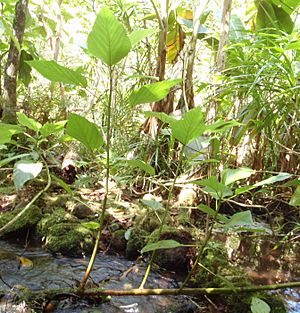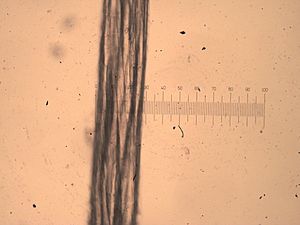Olonā facts for kids
Quick facts for kids Olonā |
|
|---|---|
 |
|
| Scientific classification | |
| Genus: |
Touchardia
|
| Species: |
latifolia
|
Touchardia latifolia, often called olonā in Hawaiian, is a type of flowering shrub. It belongs to the nettle family, called Urticaceae. Unlike many nettles you might know, olonā plants do not have stinging hairs.
This plant is endemic to Hawaii, meaning it grows naturally only there. You can find it in wet valleys and forests across most of the main Hawaiian islands. It grows at elevations from about 70 to 1200 meters (230 to 3,900 feet). The shape of olonā leaves can vary a lot, from thin to wide. This wide range once made scientists think there were many different species, but now they know it's all one plant. Olonā usually flowers between May and December. Its female flowers grow into fleshy orange, berry-like fruits, while the male flowers are white. It's quite easy to grow olonā from cuttings, but it doesn't like to be moved once it's planted because its roots are delicate.
Olonā: A Super Strong Fiber
Long ago, ancient Hawaiians grew olonā plants for their amazing fibers. These fibers were considered some of the best and strongest natural fibers on Earth. The strands of olonā intertwine, making them incredibly tough and durable.
Hawaiians used olonā fibers for many important things. They made ropes and cords, known as `cordage`. This strong cordage was essential for their tools and daily life. For example, olonā was used in Hawaiian weapons. It fastened shark teeth onto the heads of `leiomano` (a type of weapon). It also formed the wrist loops on `pāhoa` (daggers) and was used in "tripping weapons" like the `pīkoi`.
Beyond weapons, olonā fibers were used to make `fishing nets` and `carrying baskets` called `kōkō`. Its strength and durability were so well known that people from all over the world, like climbers and sailors, wanted olonā cords.
Preparing the olonā fiber was a careful process. Hawaiians would typically grow the plants near upland streams. After harvesting, the fibers were soaked in the stream for 24 to 72 hours. Then, they were placed on a long board, and a scraper (sometimes made from a shell or turtle) was used to remove the outer bark. Once prepared and dry, the bark would peel off in long, strong ribbons of fiber. The outer bark of olonā was also used to make beautiful `lei` (flower garlands) that people wore around their necks.


